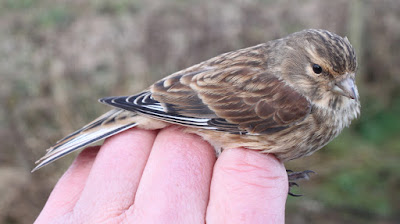Lots of Fieldfares were on the move today. And later there was a bonus bird in the shape of a Greenland White-fronted Goose.
I’d started off as usual with a drive north towards Pilling and Cockerham. The flood at Braides Farm was partly frozen where my distance-impaired counts still realised approximately 250 Lapwing, 140 Golden Plover, 180 Curlew, 40 Black-tailed Godwit, 20 Redshank and 40 Teal. There was a very tightly packed flock of about 400 gulls, mainly Black-headed, but also some Common. A black mass of birds was immediately recognisable as a post-roost huge flock of Starlings, and as they slowly dispersed left, right and centre in smaller feeding parties I counted 600+ and still some left on the ground.
Starling, Golden Plover, Lapwing
There was very little doing at Conder Green where the recurrent high water level made for a poor show on the pool. Best I could manage here were 40+ Wigeon feeding across the bund at the back of the pool, a few dozen Teal, a couple of Little Grebe, several Curlew and the obligatory Little Egret. But, 200+Teal in the creeks and the wintering Spotted Redshank.
There had been a few Fieldfares flying over Conder Green but a drive along the lanes of Jeremy and Moss suggested something of a new influx, precipitated perhaps by the overnight drop in temperatures and the overnight frost.
For readers who do not know our northern Fieldfare Turdus pilaris, it is a highly gregarious but intensely shy member of the thrush family of the Northern Hemisphere. It is very different from, but immediately separatedfrom our native UK thrushes by way of its mobile tendencies, loud ‘chacking’ call and flocking behaviour both when feeding and during its autumn migration from Scandinavia.
Fieldfares
It was hard to count the Fieldfares as flocks of them moved continually inland by following the hedgerows of Moss Lane and then across the A588 towards Thurnham Hall and beyond. There seemed to be few Redwings amongst the approximately 300 Fieldfare and of course the two species do not always coincide in the timing their migration.
Fieldfare
At Cockersands I located more than 20 Tree Sparrows, 30+ Goldfinch, 12 Collared Dove and a Pied Wagtail before I hit the road again and back towards Pilling in search of more.
I checked out a potential new ringing site offered by a local farmer where I found 40+ Linnets in attendance but using a very narrow and extremely long strip of land which might rule it out as a workable project. Not to worry, it is a useful place to keep an eye on and I did see more Fieldfares in roadside hawthorns, plus a watchful Buzzard which scattered the Fieldfares as well as feeding Woodpigeons. The farmer tells me that Buzzards wiped out all his leverets this year, which if true doesn't help the raptor's already dented reputation in the tight-knit farming and shooting community.
Buzzard
The many thousands of Pink-footed Geese have been incredibly difficult to pin down this autumn, due mostly to disturbance from autumnal farming activities, shooting pressures and disturbance from busy roads in sometimes semi-rural locations. Despite this continuous daily disruption the geese seem to find and use new and different fields in which to both feed and hide, bringing a truism to the old saying about the wisdom of undertaking a “wild goose chase”.
At last near Lane Ends today I got sight and sound of the pinkies and with them was a single adult White-fronted Goose of the Greenland race – Anser alibfrons flavirostris, in the company of c500 Pink-footed Geese. The appearance of European or Russian White-fronted Goose of the race albifrons and Greenland White-fronted Goose of the race flavirostris differ in a number of ways.
White-fronted Goose - Greenland race
The Greenland White-fronted Goose always appears darker than the European White-fronted Goose at rest and in flight.
The belly-barring on adult birds is on average more extensive on flavirostris than on albifrons.
The bill of adult Greenland White-fronts are orange-yellow at the base, but can be more pinkish-yellow on the outer-half, thus close in colour to European white-fronts on some individuals.
I spent a while with the geese before brightly clad and slow moving cyclists caused the predictable flight to pastures new, all of the geese and yours truly back home for a warming coffee.
Linking today to http://id-rather-b-birdin.blogspot.co.uk/, Eileen's Saturday and Stewart's World Bird Wednesday.
Linking today to http://id-rather-b-birdin.blogspot.co.uk/, Eileen's Saturday and Stewart's World Bird Wednesday.
















































.JPG)







.jpg)












